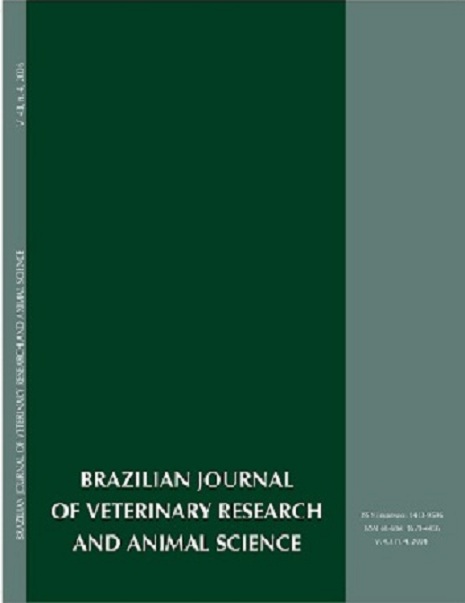Evaluation of norgestomet auricular implants reused associated to valerate or to estradiol benzoate in fixed time artifical insemination in Nelore cows
DOI:
https://doi.org/10.11606/issn.1678-4456.bjvras.2006.26460Keywords:
Progestens, Reused, Estradiol valerato, Estradiol benzoate, BovineAbstract
The use of fixed-time artificial insemination (IATF) in cows is possible by the use of drugs that aim at the synchronization of the folicular wave pool, the estrus and ovulation. In trading cattle the costs of these drugs must stablish a profitable relation with the benefits. The present study meant to compare the pregnancy rates in Nelore (Bos taurus indicus) cows inseminated at fixed-time, treated with new (IN) or once used (IR; reused) auricular releasing devices with 3mg of norgestomet (Crestar®), associated with the administration of norgestomet (NG) and estradiol valerate (VE) or progesterone (P4) and estradiol benzoate (BE). Pure breed Nelore cows (n=241), on lactation with calf received one of the four treatments: new Crestar®during 10 days administrated with 3mg of NG and 5 mg of VE (group IN/NG+VE; n=61); new Crestar®inserted during 8 days with 50mg of P4 and 2mg of BE (group IN/P4+BE; n=61); reused Crestar®inserted during 10 days in association with 3 mg of norgestomet and 5 mg of VE (group IR/NG+VE; n=58) or reused Crestar®inserted during 8 days in association with 50mg of P4 and 2mg of BE (group IR/P4+BE; n=61). On the day the releasing devices were removed the animals received 7,5mg of Luprostiol and after 24 hours 1mg of BE. A fixed-time artificial insemination was done 54 to 56 hours after the removal of the releasing devices. Cows detected in estrus after the insemination at fixed-time were observed during a period of 49 days and reinseminated. The pregnancy diagnosis was done by ultrassonography 35 days after the IATF and after the end of the breeding season. The pregnancy rates of IATF (TP IATF) and at the end of the breeding season (TP EM) were estimated. There was no interaction between the characteristics of the (new or reused) releasing devices and the treatment given at the day the releasing devices were inserted (NG+VE e P4+BE). The use of new or used CIDR®had no effect on TP IATF (48,3% vs 48,7%) and on TP EM (85,2% vs 86,5%). The treatments with NG+VE e P4+BE did not have effect on TP IATF (49,5% vs 47,5%) and TP EM (86,5 vs 85,2%). There was a effect on the number of parturition (primipara and multipara) on the TP IATF (35% vs 52,7%; P<0,01) and on TP EM (71,9% vs 90,2%; P<0,01). It can be concluded that the new or once used releasing devices with norgestomet when associated with NG+VE or P4+BE promote highly satisfatory pregnancy rates in Nelore cows, being the better rates obtained in multipara females.Downloads
Download data is not yet available.
Downloads
Published
2006-08-01
Issue
Section
UNDEFINIED
License
The journal content is authorized under the Creative Commons BY-NC-SA license (summary of the license: https://
How to Cite
1.
Almeida AB, Bertan CM, Rossa LAF, Gaspar P dos S, Binelli M, Madureira EH. Evaluation of norgestomet auricular implants reused associated to valerate or to estradiol benzoate in fixed time artifical insemination in Nelore cows. Braz. J. Vet. Res. Anim. Sci. [Internet]. 2006 Aug. 1 [cited 2024 Apr. 23];43(4):456-65. Available from: https://www.revistas.usp.br/bjvras/article/view/26460





